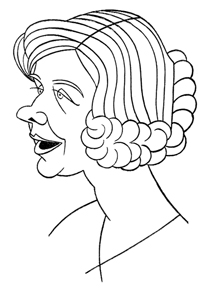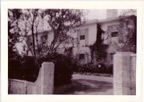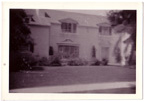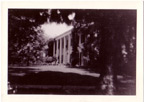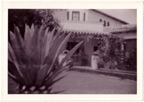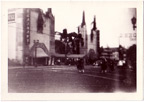ISN’T SHE SWEET!
Tag: Mary Pickford
Cladrite Classics: Jack Benny Slept Here
We were mulling over the other day some of the posts we thought particularly fun that went live in the weeks and months before Cladrite Radio had accumulated much of a readership. Would it be problematic, we wondered, to revisit some of those posts, under the heading of Cladrite Classics?
No, we decided, it would not. Hence the following revisited offering, which first saw the light of day on May 13, 2010:
Though we’re committed New Yorkers, we wouldn’t mind a bit spending a few weeks—perhaps even a few months—a year in Los Angeles. We even find ourselves daydreaming about the City of Angels quite often.
And yet, we came around slowly on L.A. Our first couple of visits were enjoyable enough, but we didn’t find the city particularly engaging. After a trio of week-long sojourns there over the past decade or so, though, we’ve been won over.
We view the city through a movie buff’s eye, primarily, and so spend our time motoring about checking out movie stars’ homes, vintage movie palaces, and locations that were used in the filming of some of our favorite classic pictures (though we’re also happy just puttering through the various old neighborhoods south of the Hollywood hills—we love the residential architecture in old L.A.).
We didn’t snap the photos shared below; we bought them at a flea market some years back. They’re snapshots taken around Hollywood and its environs back in the day. How old they are, exactly, we’re not sure—we’re inclined to think they’re from the late 1930s, but we’re open to guesses from you, gentle readers. (For larger views, just click the images.)
Unraveling a pince nez mystery
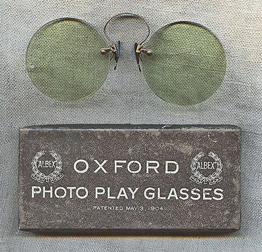 When browsing a flea market, antiques store, or the vintage corners of the internet, we love stumbling upon a product we never knew existed.
When browsing a flea market, antiques store, or the vintage corners of the internet, we love stumbling upon a product we never knew existed.
Ever heard of photo play glasses? Neither had we, until we came across the pair pictured here.
But what the heck are they, we wondered?
Our initial guess was that perhaps, in the early days of the motion picture industry, there was concern that watching movies might be bad for one’s eyes, the old “fear the new technology” gambit that’s still in play today.
This concern might have been sincere (if misguided) or ginned up by the vendor just to move some spectacles, but it wouldn’t surprise us if it existed.
So we turned to the experts over at Nitrateville.com, an online community of cineastes, collectors, and historians that we enjoy paying a visit to now and again.
Jack Theakston, assistant manager of the Capitol Theatre, a gorgeous 1928 movie palace in Rome, N. Y., offered the suggestion that the glasses were meant not to protect the eyesight of moviegoers, but of actors. In the early days of movies, Theakston said, UV-intensive klieg lights were used to illuminate the set, and actors often suffered a condition called “klieg eyes.” He also pointed out that the patent mentioned on the carton the glasses came in was not awarded for a specific use for the glasses, but for their design.
It’s an interesting notion, that a product might be created for actors to wear between takes and when they were relaxing on the set, and we certainly weren’t in position to discount the idea altogether, but we continued to harbor a sneaking suspicion that this was a product meant for the general public, not for such a niche market. We can’t prove it; it’s just a hunch. But as Mr. Theakston pointed out, Albex, the manufacturer of the glasses, dealt in industrial glasses, such as welder’s goggles, and there are contemporary accounts from the time of actors wearing sunglasses on the set to protect their eyes.
So it’s hard to say for certain.
Mike Gebert, one of the admins at Nitrateville, questioned whether the name “Photo Play Glasses” would have meant very much to the average person in 1904 (the patent date printed on the box), given that movies were in a truly nascent stage then. But upon closer inspection, he guessed that ’04 was just the date of the design patent, that the glasses themselves dated from the 1910s or even the ’20s.
His reasoning? The font on the packaging is, he says, Copperplate Gothic, which was designed in 1901. Given that fonts tend to take a while to come into popular use, he felt confident that glasses were marketed later, at which point motion pictures—photo plays, if you will—were certainly popular enough to inspire the marketing of such products.
Which kind of supports our theory, seems to us.
However, a poster from Australia named Brooksie did a little digging and learned that concern over kleig eyes was at its peak in the mid-to-late 1910s and came across suggestions that it was actors wearing shades, to use the modern vernacular, to protect their eyes from the bright lights on set that made sunglasses popular in the first place.
Which sort of leads us back to the idea that these were an industrial product, one meant for people working at making movies and not for the general public. The fear that watching movies could hurt one’s eyes may never have existed at all, except in our imagination. In any case, we’ve not turned up any solid evidence of it.
And we might well ask ourselves why we’re resisting the notion that it was actors and other filmmakers who wore Albex’s Photo Play Glasses, anyway. After all, if that’s the case, while we can’t know who owned the pair that came into our possession, we can have a good deal of fun imagining who might have possessed them. Perhaps they were once the property of Mary Pickford, John Barrymore, or even—be still, our hearts—Buster Keaton. They were all acting in movies by the 1910s, with Keaton the last of the three to the Hollywood party in 1917.
We’ll keep digging to see what we can come up with on this cinematic curio, but for now, perhaps we will allows ourselves to imagine that we now possess an item once owned by one of the giants of silent cinema.
Who can say we’re wrong, after all?
Z is for Zelda
We don’t kid ourselves that our listeners and readers can subsist on Cladrite Radio alone.
Heck, no—after all, each of us occasionally finds ourselves without internet access, and what to do then, when you’ve got a yen to do a little reading about life as it was once lived?
Well, we know what we do—we reach for a copy of Zelda magazine, and our vintage itch is immediately scratched.

As is explained on the publication’s web site, Zelda is “inspired by days gone by and our goal is to share glorious tidbits of yesteryear while bringing you features on the best of what’s happening in the vintage-style culture today.”
We’ve read Zelda (heck, we’ve contributed to it), and the above sentiments aptly sum up what this winning biannual is all about. Take it from us, from interviews with the likes of Golden Era actress Marsha Hunt, former Zeigfeld girl Doris Eaton Travis, and Turner Classic Movies on-air host Robert Osborne to recipes (culinary and cocktail), fashion history and advice, music reviews, and so much more, Zelda’s got vintage culture covered from stem to stern.
 And just to show we’re willing to put our money where our mouth is, we’re going to offer the first giveaway we’ve ever undertaken at Cladrite Radio. The first six people to email us at zeldamag@cladriteradio.com will receive a copy of the current edition of Zelda (it’s issue #3, fyi), which boasts such fascinating features as a previously unpublished interview with the man once known as “America’s boyfriend,” actor, bandleader (and second husband to Mary Pickford) Charles “Buddy” Rogers; a profile of the once-best-selling (and not a little scandalous) but now largely forgotten author Ursula Parrott; an intoxicating drink recipe that updates the classic Manhattan cocktail while remaining true to the “spirit” of the original; a guide to the proper wearing of neckties; the sage advice of “Ask Mr. Burton”; and so much more (honestly, we’re just scratching the surface here).
And just to show we’re willing to put our money where our mouth is, we’re going to offer the first giveaway we’ve ever undertaken at Cladrite Radio. The first six people to email us at zeldamag@cladriteradio.com will receive a copy of the current edition of Zelda (it’s issue #3, fyi), which boasts such fascinating features as a previously unpublished interview with the man once known as “America’s boyfriend,” actor, bandleader (and second husband to Mary Pickford) Charles “Buddy” Rogers; a profile of the once-best-selling (and not a little scandalous) but now largely forgotten author Ursula Parrott; an intoxicating drink recipe that updates the classic Manhattan cocktail while remaining true to the “spirit” of the original; a guide to the proper wearing of neckties; the sage advice of “Ask Mr. Burton”; and so much more (honestly, we’re just scratching the surface here).
So drop us a line, being sure to include your name and mailing address, and if yours is one of the first six entries we receive, we’ll get a copy of Zelda right off to you.
Such a deal!
Watching the stars come out
We have a grand time when we visit Los Angeles (pronounce it “Angle-eez,” with the hard G, if you please). As movie buffs, we get a kick out of just driving around the various neighborhoods and imagining who once lived in the bungalows we’re passing. Lucille Ball, f’rinstance.
Then there are the more substantial residences that the familiar stars of the Golden Age of Hollywood moved into, once they’d hit it big.
In our several trips to Tinsel Town, we’ve never taken one of the commercial tours of the stars’ homes, but we suspect they tend to focus on the abodes of contemporary stars—Tom Hanks, Julia Roberts, Justin Bieber—at the expense of the former residences of your Humphrey Bogarts, your Bette Davises, your Una Merkels. And who can blame them? It’s always good policy to give the people what they want, and we who are more interested in seeing where and how the stars of yesteryear lived are undeniably in the minority.
There are guidebooks that provide pointers that allow us to catch a glimpse of where Bogart, Davis, and Merkel lived, worked, and played, of course (we’re partial to Richard Alleman’s Hollywood: The Movie Lover’s Guide: The Ultimate Insider Tour of Movie L.A.), but what if one doesn’t have the wherewithal (or accrued vacation days) to to arrange a Southern California sojorn?
In that case, one turns, as one tends to do these days, to the internet—specifically to Image-Archeology.com and their collection of vintage linen postcards that depict the residences of those performers who made our parents, grandparents, and great-grandparents laugh, cry and tap their toes (though not simultaneously).
 |
 |
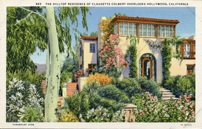 |
| Mary Pickford and Douglas Fairbanks’ home, Pickfair |
Jean Harlow’s Beverily Hills residence | Claudette Colbert’s hilltop residence in Hollywood |
At this delightful site, one can gaze upon a palatial Hancock Park home while imagining Buster Keaton stepping out to pick up the morning paper, compare contrast two of Groucho Marx‘s Beverly Hills homes, and kill two birds with one stone as you assess the love nest once blissfully shared by a pair of stars who were married once upon a time, Dick Powell and Joan Blondell.
And the list goes on—Myrna Loy, Harold Lloyd, Ginger Rogers, Barbara Stanwyck; one could grow breathless reciting them. All the cards, from A to Z (well, A to Y—Loretta Young is the last star on the list) are in terrific shape and lovingly presented. We encourage all our readers to experience a little California sunshine by spending some time there.

